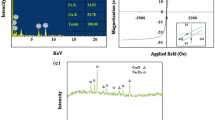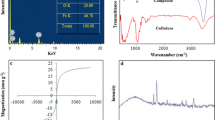Abstract
The present work studies the adsorptive removal of methylene blue (MB) dye from aqueous solution using a novel biocompatible adsorbent based on hydroxypropyl cellulose (HPC) and itaconic acid nanogels. The biocompatible adsorbent was characterized using scanning electron microscopy, Fourier transform infrared spectroscopy and dynamic light scattering analyses. Response surface methodology was used to modeling and optimization of the adsorption process. A second-order empirical relationship between adsorption capacity and independent variables (pH of the solution, contact time and dye concentration) was obtained. The results of design of experiments demonstrated that the predicted values were well fitted with the experimental data where coefficient of determination (R2) equaled 0.9861. Pareto analysis for identification of the factors effect on the system revealed that the initial concentration of MB was the most effective parameter. Maximum removal efficiency (99.9%) was achieved at optimum parameters where pH, MB concentration, and contact time were 5.6, 130 mg L−1, and 5 min, respectively. Furthermore, the adsorption experimental data were well fitted to the Temkin isotherm and pseudo-second-order kinetic model. Consequently, it was found out that the HPC–PIA nanogels with high adsorption capacity (nearly 761 mg g−1) can be a suitable adsorbent for removal of cationic dyes from textile colored wastewaters.







Similar content being viewed by others
References
Entezari M, Al-Hoseini ZS, Ashraf N (2008) Fast and efficient removal of reactive black 5 from aqueous solution by a combined method of ultrasound and sorption process. Ultrason Sonochem 15(4):433–437
Gong R, Li M, Yang C, Sun Y, Chen J (2005) Removal of cationic dyes from aqueous solution by adsorption on peanut hull. J Hazard Mater 121(1):247–250
Mahida VP, Patel MP (2016) Removal of some most hazardous cationic dyes using novel poly (NIPAAm/AA/N-allylisatin) nanohydrogel. Arab J Chem 9(3):430–442
Rahman MM, Choudhury FA, Hossain MD, Chowdhury MNI, Mohsin S, Hasan MM, Uddin MF, Sarker NC (2014) A Comparative study on the photocatalytic degradation of industrial dyes using modified commercial and synthesized TiO2 photocatalysts. J Chem Eng 27(2):65–71
Zollinger H (2003) Color chemistry: syntheses, properties, and applications of organic dyes and pigments. Wiley, London
Habibi MH, Hassanzadeh A, Mahdavi S (2005) The effect of operational parameters on the photocatalytic degradation of three textile azo dyes in aqueous TiO2 suspensions. J Photochem Photobiol A Chem 172(1):89–96
Hakam A, Rahman IA, Jamil MSM, Othaman R, Amin MCIM, Lazim MASM (2015) Removal of methylene blue dye in aqueous solution by sorption on a bacterial-g-poly-(acrylic acid) polymer network hydrogel. Sains Malays 44(6):827–834
Frankenburg FR, Baldessarini RJ (2008) Neurosyphilis, malaria, and the discovery of antipsychotic agents. Harvard Rev Psychiatry 16(5):299–307
Oz M, Lorke DE, Petroianu GA (2009) Methylene blue and Alzheimer’s disease. Biochem Pharmacol 78(8):927–932
Lin S, Lo C (1996) Treatment of textile wastewater by foam flotation. Environ Technol 17(8):841–849
Tahir S, Rauf N (2006) Removal of a cationic dye from aqueous solutions by adsorption onto bentonite clay. Chemosphere 63(11):1842–1848
Qiu H, Lv L, Pan B-c, Zhang Q-j, Zhang W-m, Zhang Q-x (2009) Critical review in adsorption kinetic models. J Zhejiang Univ Sci A 10(5):716–724
Carmen Z, Daniela S (2012) Textile organic dyes-characteristics, polluting effects and separation/elimination procedures from industrial effluents—a critical overview. In: Puzyn T (ed) Organic pollutants ten years after the stockholm convention-environmental and analytical update. InTech, Croatia, pp 55–81
Wen X, Qiao X, Han X, Niu L, Huo L, Bai G (2016) Multifunctional magnetic branched polyethylenimine nanogels with in situ generated Fe3O4 and their applications as dye adsorbent and catalyst support. J Mater Sci 51(6):3170–3181
Zhang X, Malhotra S, Molina M, Haag R (2015) Micro-and nanogels with labile crosslinks—from synthesis to biomedical applications. Chem Soc Rev 44(7):1948–1973
Koetting MC, Peters JT, Steichen SD, Peppas NA (2015) Stimulus-responsive hydrogels: theory, modern advances, and applications. Mater Sci Eng R Rep 93:1–49
Sharma A, Garg T, Aman A, Panchal K, Sharma R, Kumar S, Markandeywar T (2016) Nanogel-an advanced drug delivery tool: current and future. Artif Cells Nanomed Biotechnol 44(1):165–177
Honarkar H, Barikani M (2009) Applications of biopolymers I: chitosan. Monatsh Chem Chem Mon 140(12):1403
Hu D, Wang P, Ma Q, Wang L (2016) Preparation of a cellulose-based adsorbent with covalently attached hydroxypropyl dodecyldimethylammonium groups for the removal of CI Reactive Blue 21 dye from aqueous solution. Desalin Water Treat 57(23):10604–10615
Üzüm ÖB, Karadağ E (2011) Dye sorption and water uptake properties of crosslinked acrylamide/sodium methacrylate copolymers and semi-interpenetrating polymer networks composed of PEG. Sep Sci Technol 46(3):489–499
Wang R, Yu B, Jiang X, Yin J (2012) Understanding the host-guest interaction between responsive core-crosslinked hybrid nanoparticles of hyperbranched poly (ether amine) and dyes: the selective adsorption and smart separation of dyes in water. Adv Funct Mater 22(12):2606–2616
Hoshino Y, Imamura K, Yue M, Inoue G, Miura Y (2012) Reversible absorption of CO2 triggered by phase transition of amine-containing micro-and nanogel particles. J Am Chem Soc 134(44):18177–18180
Atta A, Akl MA, Youssef AM, Ibraheim MA (2013) Superparamagnetic core-shell polymeric nanocomposites for efficient removal of methylene blue from aqueous solutions. Adsorpt Sci Technol 31(5):397–419
Akl MA, Sarhan AA, Shoueir KR, Atta AM (2013) Application of crosslinked ionic poly (vinyl alcohol) nanogel as adsorbents for water treatment. J Dispers Sci Technol 34(10):1399–1408
Lakouraj MM, Mojerlou F, Zare EN (2014) Nanogel and superparamagnetic nanocomposite based on sodium alginate for sorption of heavy metal ions. Carbohyd Polym 106:34–41
Chatterjee S, Kumar A, Basu S, Dutta S (2012) Application of response surface methodology for methylene blue dye removal from aqueous solution using low cost adsorbent. Chem Eng J 181:289–299
Dutta S, Bhattacharyya A, Ganguly A, Gupta S, Basu S (2011) Application of response surface methodology for preparation of low-cost adsorbent from citrus fruit peel and for removal of methylene blue. Desalination 275(1):26–36
Jahangiri M, Bagheri M, Farshi F, Abbasi F (2015) Optimized synthesis of hydroxypropyl cellulose-g-poly (ε-caprolactone) network. J Poly Res 22(10):1–13
Olad A, Farshi Azhar F, Shargh M, Jharfi S (2014) Application of response surface methodology for modeling of reactive dye removal from solution using starch-montmorillonite/polyaniline nanocomposite. Polym Eng Sci 54(7):1595–1607
Silva JP, Sousa S, Gonçalves I, Porter JJ, Ferreira-Dias S (2004) Modelling adsorption of acid orange 7 dye in aqueous solutions to spent brewery grains. Sep Purif Technol 40(2):163–170
Qiu X, Hu S (2013) “Smart” materials based on cellulose: a review of the preparations, properties, and applications. Materials 6(3):738–781
Pulat M, Eksi H (2006) Determination of swelling behavior and morphological properties of poly (acrylamide-co-itaconic acid) and poly (acrylic acid-co-itaconic acid) copolymeric hydrogels. J Appl Polym Sci 102(6):5994–5999
Betancourt T, Pardo J, Soo K, Peppas NA (2010) Characterization of pH-responsive hydrogels of poly (itaconic acid-g-ethylene glycol) prepared by UV-initiated free radical polymerization as biomaterials for oral delivery of bioactive agents. J Biomed Mater Res A 93(1):175–188
Hassanpour S, Bagheri M (2017) Dual-responsive semi-IPN copolymer nanogels based on poly (itaconic acid) and hydroxypropyl cellulose as a carrier for controlled drug release. J Polym Res 24(6):91
Liang C, Rogers C, Malafeew E (1997) Investigation of shape memory polymers and their hybrid composites. J Intell Mater Syst Struct 8(4):380–386
Özcan A, Ömeroğlu Ç, Erdoğan Y, Özcan AS (2007) Modification of bentonite with a cationic surfactant: an adsorption study of textile dye reactive blue 19. J Hazard Mater 140(1):173–179
Ma L, Kang H, Liu R, Huang Y (2010) Smart assembly behaviors of hydroxypropyl cellulose-graft-poly (4-vinyl pyridine) copolymers in aqueous solution by thermo and pH stimuli. Langmuir 26(23):18519–18525
Miller JN, Miller JC (2005) Statistics and chemometrics for analytical chemistry. Pearson Education, New York
Moghaddam SS, Alavi Moghaddam MR, Arami M (2012) Response surface optimization of acid red 119 dye adsorption by mixtures of dried sewage sludge and sewage sludge ash. Clean Soil Air Water 40(6):652–660
Zhu H-Y, Fu Y-Q, Jiang R, Yao J, Xiao L, Zeng G-M (2012) Novel magnetic chitosan/poly (vinyl alcohol) hydrogel beads: preparation, characterization and application for adsorption of dye from aqueous solution. Bioresour Technol 105:24–30
Pandey S, Mishra SB (2011) Organic–inorganic hybrid of chitosan/organoclay bionanocomposites for hexavalent chromium uptake. J Colloid Interface Sci 361(2):509–520
Gimbert F, Morin-Crini N, Renault F, Badot P-M, Crini G (2008) Adsorption isotherm models for dye removal by cationized starch-based material in a single component system: error analysis. J Hazard Mater 157(1):34–46
Langmuir I (1918) The adsorption of gases on plane surfaces of glass, mica and platinum. J Am Chem Soc 40(9):1361–1403
Freundlich H (1906) Over the adsorption in solution. J Phys Chem 57(385471):1100–1107
Hameed B, Tan I, Ahmad A (2008) Optimization of basic dye removal by oil palm fibre-based activated carbon using response surface methodology. J Hazard Mater 158(2):324–332
Bayramoglu G, Altintas B, Arica MY (2009) Adsorption kinetics and thermodynamic parameters of cationic dyes from aqueous solutions by using a new strong cation-exchange resin. Chem Eng J 152(2):339–346
Tempkin M, Pyzhev V (1940) Kinetics of ammonia synthesis on promoted iron catalyst. Acta Phys Chim USSR 12(1):327
Auta M, Hameed B (2011) Optimized waste tea activated carbon for adsorption of methylene blue and acid blue 29 dyes using response surface methodology. Chem Eng J 175:233–243
Roosta M, Ghaedi M, Daneshfar A, Sahraei R, Asghari A (2014) Optimization of the ultrasonic assisted removal of methylene blue by gold nanoparticles loaded on activated carbon using experimental design methodology. Ultrason Sonochem 21(1):242–252
Tehrani MS, Zare-Dorabei R (2016) Competitive removal of hazardous dyes from aqueous solution by MIL-68 (Al): derivative spectrophotometric method and response surface methodology approach. Acta A Mol Biomol Spectrosc 160:8–18
Ghaedi M, Pakniat M, Mahmoudi Z, Hajati S, Sahraei R, Daneshfar A (2014) Synthesis of nickel sulfide nanoparticles loaded on activated carbon as a novel adsorbent for the competitive removal of methylene blue and safranin-O. Spectrochim Acta A Mol Biomol Spectrosc 123:402–409
Sadhukhan B, Mondal NK, Chattoraj S (2016) Optimisation using central composite design (CCD) and the desirability function for sorption of methylene blue from aqueous solution onto Lemna major. Karbala Int J Mod Sci 2(3):145–155
Ghaedi M, Ghazanfarkhani MD, Khodadoust S, Sohrabi N, Oftade M (2014) Acceleration of methylene blue adsorption onto activated carbon prepared from dross licorice by ultrasonic: equilibrium, kinetic and thermodynamic studies. J Ind Eng Chem 20(4):2548–2560
Acknowledgements
We thank the Vice Chancellor of Research of Azarbaijan Shahid Madani University, for financially supporting this research.
Author information
Authors and Affiliations
Corresponding authors
Rights and permissions
About this article
Cite this article
Hassanpour, S., Farshi Azhar, F. & Bagheri, M. Novel nanogels based on hydroxypropyl cellulose–poly(itaconic acid) for adsorption of methylene blue from aqueous solution: process modeling and optimization using response surface methodology. Polym. Bull. 76, 933–952 (2019). https://doi.org/10.1007/s00289-018-2419-6
Received:
Revised:
Accepted:
Published:
Issue Date:
DOI: https://doi.org/10.1007/s00289-018-2419-6




